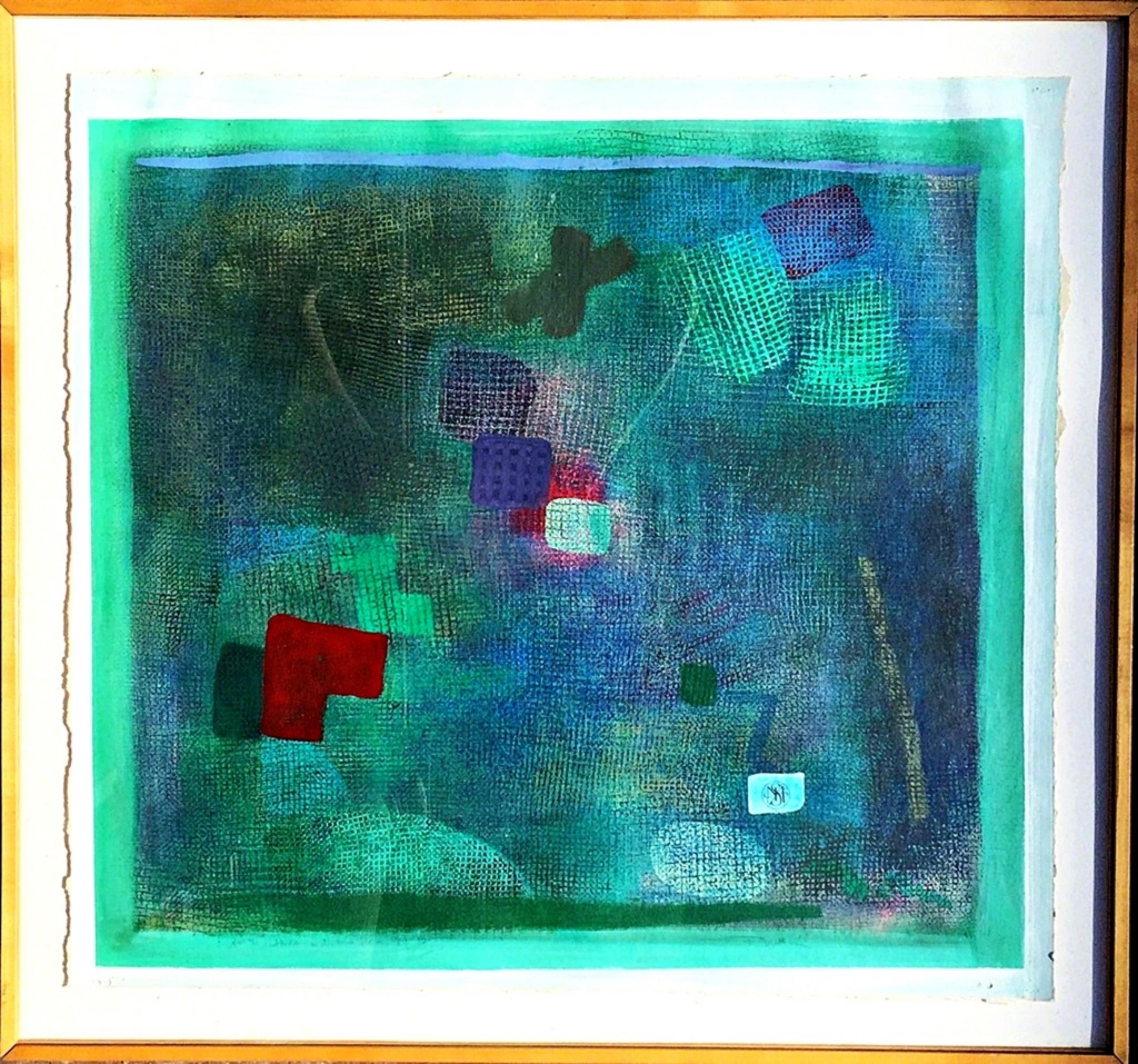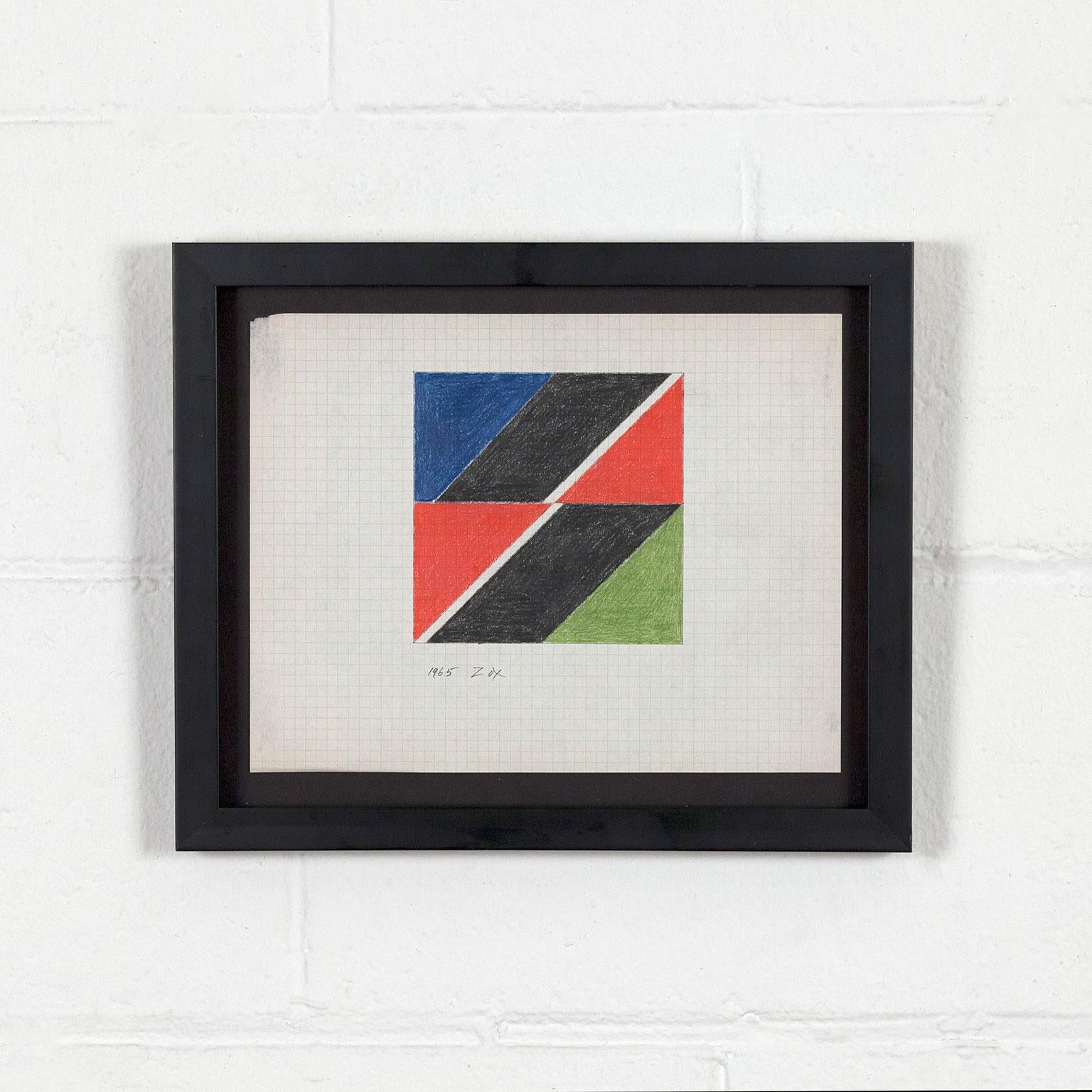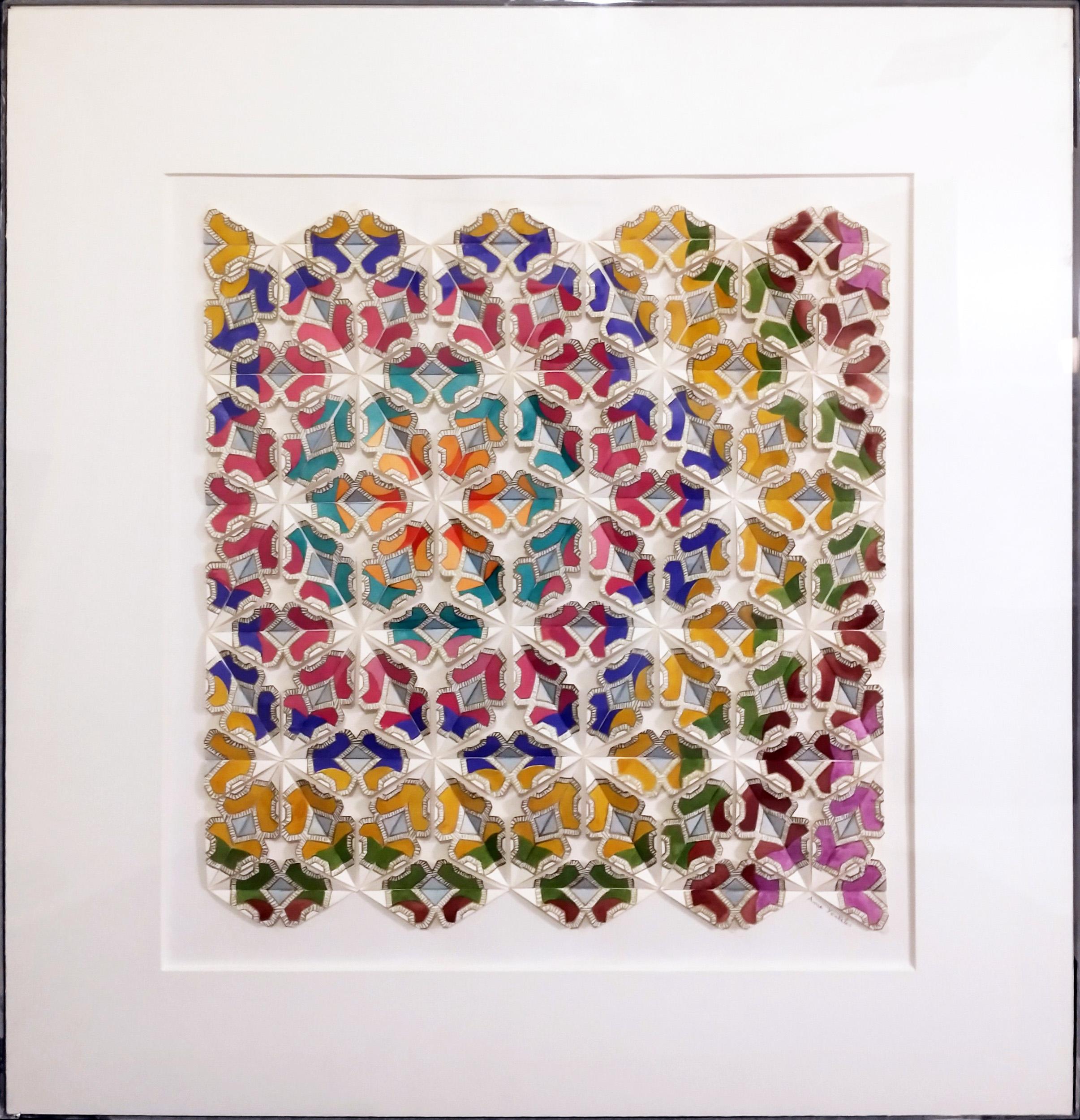Items Similar to Larry Zox "Teal Top" Drawing, 1966
Want more images or videos?
Request additional images or videos from the seller
1 of 9
Larry ZoxLarry Zox "Teal Top" Drawing, 1966 1966
1966
About the Item
Larry Zox (1937-2006) was a central figure in the evolution of 20th century abstraction in America.
Raised in Des Moines, Iowa, Zox studied at the University of Oklahoma and went on to work under the tutelage of modernist Georg Grosz at the Des Moines Art Centre. Zox moved to New York City and established his reputation by the mid 1960's. His studio was located on 20th Street and he was surrounded and inspired by a melting pot of jazz artists, bikers, and boxers.
Zox was one of the most successful practitioners of hard-edge or geometric abstraction and not surprisingly was championed by Frank Stella, amongst others.
By the mid 1960's, Zox arrived at his most recognized style, utilizing hard-edge shapes in bold colors to create geometric patterns, which were often realized on raw canvas.
Zox's hard-edge geometric creations from the late 1960's and early 1970's are arguably the most recognizable works from his oeuvre. Fittingly he had a retrospective at the Whitney Museum in 1973, that focused on such work. Today, numerous museums including the Whitney, the MoMA, the Tate and the Metropolitan all have examples of his work from this era in their permanent collections.
While Zox is not directly associated with the Op Art movement, many of his works by nature of their patterns and colors create visual illusions in dimensionality. In "Mosaic" the kelly green band that intersect the composition helps give the overall work an appearance of a slanted stair.
Frequently the artist seems to be inviting the viewer to find pattern within the work. In "Mosaic" we have both areas of synergy and dissonance. Can you find them?
Questions about this piece? Contact us!
Teal Top
Signed and dated by the artist
Mixed media on paper
USA, 1966
8.5"H 10.5"W (work)
Very good condition
- Creator:Larry Zox (1936-2006, American)
- Creation Year:1966
- Dimensions:Height: 8.5 in (21.59 cm)Width: 10.5 in (26.67 cm)
- Medium:
- Movement & Style:
- Period:
- Condition:
- Gallery Location:Toronto, CA
- Reference Number:
About the Seller
4.8
Vetted Seller
These experienced sellers undergo a comprehensive evaluation by our team of in-house experts.
Established in 2009
1stDibs seller since 2015
172 sales on 1stDibs
Typical response time: 1 hour
- ShippingRetrieving quote...Ships From: Toronto, Canada
- Return PolicyA return for this item may be initiated within 3 days of delivery.
More From This SellerView All
- Larry Zox "Black Push" Drawing, 1965By Larry ZoxLocated in Toronto, OntarioLarry Zox (1937-2006) was a central figure in the evolution of 20th century abstraction in America. Raised in Des Moines, Iowa, Zox studied at the University of Oklahoma and went o...Category
1960s Abstract Geometric Abstract Drawings and Watercolors
MaterialsPaper, Mixed Media
- Larry Zox "Minus" DrawingBy Larry ZoxLocated in Toronto, OntarioLarry Zox (1937-2006) was a central figure in the evolution of 20th century abstraction in America. Raised in Des Moines, Iowa, Zox studied at the University of Oklahoma and went o...Category
1960s Abstract Geometric Abstract Drawings and Watercolors
MaterialsPaper, Mixed Media
- Larry Zox "Mosaic" Drawing, 1966By Larry ZoxLocated in Toronto, OntarioLarry Zox (1937-2006) was a central figure in the evolution of 20th century abstraction in America. Raised in Des Moines, Iowa, Zox studied at the University of Oklahoma and went o...Category
1960s Abstract Geometric Abstract Drawings and Watercolors
MaterialsPaper, Mixed Media
- Larry Zox "Meta Center" Drawing, 1965By Larry ZoxLocated in Toronto, OntarioLarry Zox (1937-2006) was a central figure in the evolution of 20th century abstraction in America. Raised in Des Moines, Iowa, Zox studied at the University of Oklahoma and went o...Category
1960s Abstract Geometric Abstract Drawings and Watercolors
MaterialsPaper, Mixed Media
- Larry Zox "Untitled (Push)" DrawingBy Larry ZoxLocated in Toronto, OntarioLarry Zox (1937-2006) was a central figure in the evolution of abstraction in American art of the 20th century. Raised in Des Moines, Iowa, Zox studied at the University of Okla...Category
1960s Abstract Geometric Abstract Drawings and Watercolors
MaterialsPaper, Color Pencil
- Larry Zox "Diamond Drill Series" DrawingBy Larry ZoxLocated in Toronto, OntarioLarry Zox (1937-2006) was a central figure in the evolution of abstraction in American art of the 20th century. Raised in Des Moines, Iowa, Zox studied at the University of Oklaho...Category
1960s Abstract Geometric Abstract Drawings and Watercolors
MaterialsPaper, Color Pencil
You May Also Like
- Unique drawing Geometric Abstraction on postcard conceptual art (hand signed)By Sol LeWittLocated in New York, NYSol LeWitt Unique Geometric Abstraction on Postcard, 1982 Original drawing done on postcard from the Van Gogh Museum (Amsterdam), mailed, stamped and postmarked (franked) from Spolet...Category
1980s Abstract Geometric Abstract Drawings and Watercolors
MaterialsInk, Postcard, Mixed Media, Offset
- "This is for Nadine": hand signed unique marker drawing in exhibition catalogueBy James SienaLocated in New York, NYJames Siena "This is for Nadine", signed drawing, 2005 Original drawing done in black marker, bound in the title page of softcover PACE Gallery catalogue with stiff wraps hand signe...Category
Early 2000s Abstract Geometric Abstract Drawings and Watercolors
MaterialsPaper, Ink, Mixed Media, Lithograph, Offset, Felt Pen
- Lyrical Abstraction Abstract Expressionist painting for Sonoma CA (signed heart)By Robert NatkinLocated in New York, NYRobert Natkin Lyrical Abstraction for the Sonoma Mission Inn, Sonoma, California, 1990 Acrylic on paper painting with collaged element Signed twice by the ...Category
1990s Abstract Geometric Abstract Paintings
MaterialsPaper, Mixed Media, Acrylic, Pencil
- UntitledBy Anne YoukelesLocated in Long Island City, NYAnne Youkeles' work blurs the line between painting and sculpture. Her works on paper, like this one, are made with several folded pieces of paper, cut, colored, and placed together ...Category
1970s Abstract Geometric Abstract Drawings and Watercolors
MaterialsMixed Media, Paper
- 1950s Abstract Composition in Brown, Orange and Blue with Black Parallel LinesBy Herbert BayerLocated in Denver, COWatercolor and ink on paper of an abstract composition of brown, orange and blue shapes between black parallel lines throughout the the piece by Herbert Bayer (1900-1985). Presented in a custom black frame with all archival materials. Framed dimensions measure 17 ⅞ x 22 ⅝ x 1 inches. Image size is 10 ¼ x 15 ½ inches. Painting is clean and in very good condition - please contact us for a detailed condition report. Expedited and international shipping is available - please contact us for a quote. About the Artist: Herbert Bayer enjoyed a versatile sixty-year career spanning Europe and America that included abstract and surrealist painting, sculpture, environmental art, industrial design, architecture, murals, graphic design, lithography, photography and tapestry. He was one of the few “total artists” of the twentieth century, producing works that “expressed the needs of an industrial age as well as mirroring the advanced tendencies of the avant-garde.” One of four children of a tax revenue officer growing up in a village in the Austrian Salzkammergut Lake region, Bayer developed a love of nature and a life-long attachment to the mountains. A devotee of the Vienna Secession and the Vienna Workshops (Wiener Werkstätte) whose style influenced Bauhaus craftsmen in the 1920s, his dream of studying at the Academy of Art in Vienna was dashed at age seventeen by his father’s premature death. In 1919 Bayer began an apprenticeship with architect and designer, Georg Schmidthamer, where he produced his first typographic works. Later that same year he moved to Darmstadt, Germany, to work at the Mathildenhöhe Artists’ Colony with architect Emanuel Josef Margold of the Viennese School. As his working apprentice, Bayer first learned about the design of packages – something entirely new at the time – as well as the design of interiors and graphics of a decorative expressionist style, all of which later figured in his professional career. While at Darmstadt, he came across Wassily Kandinsky’s book, Concerning the Spiritual in Art, and learned of the new art school, the Weimar Bauhaus, in which he enrolled in 1921. He initially attended Johannes Itten’s preliminary course, followed by Wassily Kandinsky’s workshop on mural painting. Bayer later recalled, “The early years at the Bauhaus in Weimar became the formative experience of my subsequent work.” Following graduation in 1925, he was appointed head of the newly-created workshop for print and advertising at the Dessau Bauhaus that also produced the school’s own print works. During this time he designed the “Universal” typeface emphasizing legibility by removing the ornaments from letterforms (serifs). Three years later he left the Bauhaus to focus more on his own artwork, moving to Berlin where he worked as a graphic designer in advertising and as an artistic director of the Dorland Studio advertising agency. (Forty years later he designed a vast traveling exhibition, catalog and poster -- 50 Jahre Bauhaus -- shown in Germany, South America, Japan, Canada and the United States.) In pre-World War II Berlin he also pursued the design of exhibitions, painting, photography and photomontage, and was art director of Vogue magazine in Paris. On account of his previous association with the Bauhaus, the German Nazis removed his paintings from German museums and included him among the artists in a large exhibition entitled Degenerate Art (Entartete Kunst) that toured German and Austrian museums in 1937. His inclusion in that exhibition and the worsening political conditions in Nazi Germany prompted him to travel to New York that year with Marcel Breuer, meeting with former Bauhaus colleagues, Walter Gropius and László Moholy-Nagy to explore the possibilities of employment after immigration to the United States. In 1938 Bayer permanently relocated to the United States, settling in New York where he had a long and distinguished career in practically every aspect of the graphic arts, working for drug companies, magazines, department stores, and industrial corporations. In 1938 he arranged the exhibition, “Bauhaus 1919-1928” at the Museum of Modern Art, followed later by “Road to Victory” (1942, directed by Edward Steichen), “Airways to Peace” (1943) and “Art in Progress” (1944). Bayer’s designs for “Modern Art in Advertising” (1945), an exhibition of the Container Corporation of America (CAA) at the Art Institute of Chicago, earned him the support and friendship of Walter Paepcke, the corporation’s president and chairman of the board. Paepcke, whose embrace of modern currents and design changed the look of American advertising and industry, hired him to move to Aspen, Colorado, in 1946 as a design consultant transforming the moribund mountain town into a ski resort and a cultural center. Over the next twenty-eight years he became an influential catalyst in the community as a painter, graphic designer, architect and landscape designer, also serving as a design consultant for the Aspen Cultural Center. In the summer of 1949 Bayer promoted through poster design and other design work Paepcke’s Goethe Bicentennial Convocation attended by 2,000 visitors to Aspen and highlighted by the participation of Albert Schweitzer, Arthur Rubenstein, Jose Ortega y Gasset and Thornton Wilder. The celebration, held in a tent designed by Finnish architect Eero Saarinen, led to the establishment that same year of the world-famous Aspen Music Festival and School regarded as one of the top classical music venues in the United States, and the Aspen Institute for Humanistic Studies in (now the Aspen Institute), promoting in Paepcke’s words “the cross fertilization of men’s minds.” In 1946 Bayer completed his first architecture design project in Aspen, the Sundeck Ski Restaurant, at an elevation of 11,300 feet on Ajax Mountain. Three years later he built his first studio on Red Mountain, followed by a home which he sold in 1953 to Robert O. Anderson, founder of the Atlantic Richfield Company who became very active in the Aspen Institute. Bayer later designed Anderson’s terrace home in Aspen (1962) and a private chapel for the Anderson family in Valley Hondo, New Mexico (1963). Transplanting German Bauhaus design to the Colorado Rockies, Bayer created along with associate architect, Fredric Benedict, a series of buildings for the modern Aspen Institute complex: Koch Seminar Building (1952), Aspen Meadows guest chalets and Center Building (both 1954), Health Center and Aspen Meadows Restaurant (Copper Kettle, both 1955). For the grounds of the Aspen Institute in 1955 Bayer executed the Marble Garden and conceived the Grass Mound, the first recorded “earthwork” environment In 1973-74 he completed Anderson Park for the Institute, a continuation of his fascination with environmental earth art. In 1961 he designed the Walter Paepcke Auditorium and Memorial Building, completing three years later his most ambitious and original design project – the Musical Festival Tent for the Music Associates of Aspen. (In 2000 the tent was replaced with a design by Harry Teague.) One of Bayer’s ambitious plans from the 1950s, unrealized due to Paepcke’s death in 1960, was an architectural village on the outskirts of the Aspen Institute, featuring seventeen of the world’s most notable architects – Walter Gropius, Marcel Breuer, I.M. Pei, Minoru Yamasaki, Edward Durrell Stone and Phillip Johnson – who accepted his offer to design and build houses. Concurrent with Bayer’s design and consultant work while based in Aspen for almost thirty years, he continued painting, printmaking, and mural work. Shortly after relocating to Colorado, he further developed his “Mountains and Convolutions” series begun in Vermont in 1944, exploring nature’s fury and repose. Seeing mountains as “simplified forms reduced to sculptural surface in motion,” he executed in 1948 a series of seven two-color lithographs (edition of 90) for the Colorado Springs Fine Arts Center. Colorado’s multi-planal typography similarly inspired Verdure, a large mural commissioned by Walter Gropius for the Harkness Commons Building at Harvard University (1950), and a large exterior sgraffito mural for the Koch Seminar Building at the Aspen Institute (1953). Having exhausted by that time the subject matter of “Mountains and Convulsions,” Bayer returned to geometric abstractions which he pursued over the next three decades. In 1954 he started the “Linear Structure” series containing a richly-colored balance format with bands of sticks of continuously modulated colors. That same year he did a small group of paintings, “Forces of Time,” expressionist abstractions exploring the temporal dimension of nature’s seasonal molting. He also debuted a “Moon and Structure” series in which constructed, architectural form served as the underpinning for the elaboration of color variations and transformations. Geometric abstraction likewise appeared his free-standing metal sculpture, Kaleidoscreen (1957), a large experimental project for ALCOA (Aluminum Corporation of America) installed as an outdoor space divider on the Aspen Meadows in the Aspen Institute complex. Composed of seven prefabricated, multi-colored and textured panels, they could be turned ninety degrees to intersect and form a continuous plane in which the panels recomposed like pieces of a jigsaw puzzle. He similarly used prefabricated elements for Articulated Wall, a very tall free-standing sculpture commissioned for the Olympic Games in Mexico...Category
1950s Abstract Geometric Abstract Drawings and Watercolors
MaterialsPaper, Ink, Mixed Media, Watercolor
- Otras palabras 1By Miriam PeraltaLocated in New York, NYMiriam Peralta Otras palabras 1, 2006 Mixed media on paper 28.50h x 43w in 72.39h x 109.22w cmCategory
2010s Abstract Geometric Abstract Drawings and Watercolors
MaterialsPaper, Mixed Media





